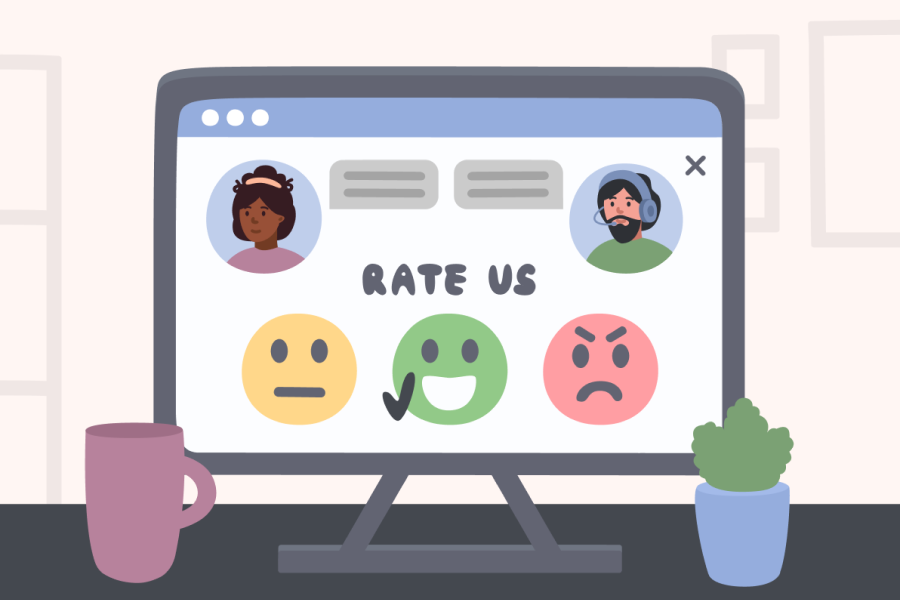Onboarding is like a courting period in your relationship with a customer. Sounds nice, yet—just like in any relationship—many things can go wrong. You can be too complex, and the customer will soon tire of guessing how to use your product. Your welcoming activities can be too intrusive, and the customer will decide that your services are not a time saver but a burden. Your advertising slogans can promise the moon, then you will watch the disappointed customer striving toward your competitor’s doors.
Okay, that's pretty obvious that there are thousands of ways to annoy new customers. And only the smooth onboarding experience can make your customers slide to the loyal audience lands with radiant smiles on their faces.
Did you know that 74% of customers won’t continue with a business that doesn't onboard them well? That’s quite a lot. Let’s find out what customer onboarding metrics may help to polish this path.
Contents
Definition of the customer onboarding process

Well, the customer onboarding experience is what a new customer or user goes through while interacting with your product or service for the first time. Sometimes, it’s just a single moment in time (e.g., when a buyer brings home your chocolate, finds out how to open it up, and tastes the first bar).
At other times, it’s a set of actions one can take within a few minutes or stretch for days (e.g., when a gamer installs a mobile arcade, creates an account, learns the rules, explores the settings, etc.).
How do you understand more precisely what is included in the process of the client onboarding journey in your case? There is a way to go: identify all the steps a new customer takes to adopt your product or service. Without further analytics, let’s consider two examples:
- A person who comes to your bank intending to open a corporate account and get a personal assistant to enhance financial task performance within the company. Their onboarding will last from the first contact with a bank manager until they fluently use the account to run all the financial operations needed.
- Or let’s take customer journey mapping in SaaS when someone purchased, say, a 12-month seat. A SaaS customer onboarding flow starts even before the purchase. And it will last until they don’t need any assistance to use the platform’s features and clearly see the value it provides.
To better understand your customer onboarding process, you might want to visualize it. For example, draw a step-by-step client onboarding journey scheme. But it will tell little about customer experience during onboarding. Instead, we encourage you to opt for journey mapping. This methodology is one of the best ways to get an insight into the customer experience during any stage of their interaction with a brand, product, company, or service. Onboarding included.
You would:
- run some interviews and surveys;
- define every onboarding interaction with a customer;
- identify the channels they use to connect with you;
- list the objectives they aim to achieve;
- track their actions on the way to fulfilling their jobs to be done;
- pay attention to the people they interact with in your organization;
- and add lots of other important customer data.
Pro tip: You may go further and not just map your customer’s journey but enrich it with customer onboarding metrics. Thus, you will get an insight into how those interconnect with customer experience. That’s an idea-driving approach that will never let you down when backed up with product analytics and research data.
Most common customer onboarding metrics
You can turn any aspect of customer interaction with your brand into onboarding KPIs throughout the onboarding phase, from feature adoption rate to customer lifetime value.
Only you decide what points are worth paying close attention to and how to measure them. But before reinventing the wheel, it's wise to look at the customer onboarding metrics already used by other professionals. They can help you shed light on the success and effectiveness of the onboarding in your company.
Time to first value

How long does it take your customers or users to realize the value of your product or service for the first time? Imagine that you bought a package of vitamins and ordered cleaning on the same day. Most likely, you will feel the benefits of taking vitamins in a few months. Meanwhile, the washed floors will please you immediately.
Of course, the business specifics somehow determine this metric. For example, there are cases when you:
- Sell a home stretching machine, but the instructions are not clear enough. The buyer, Sam, is engaged, but he doesn’t feel any effect, and, seeing no value, he asks for a refund or just buys nothing from you again.
- Create a mobile application to mark the movies watched. The new user, Stacy, intends to see how handy it is right after the installation. Yet the app is too bugged, or she doesn’t get how to use its features, and then Stacy simply puts it into a virtual trash bin.
It’s a very common thing—80% of people interacting with a new application delete it if they can’t grasp its functionality.
Indeed, the sooner customers realize they made the right choice by ordering raw materials from you or using your accountant services, the better their onboarding experience will be.
Trial conversion rate

It's one of the best metrics to see how effective your onboarding is. It shows how many people turn to customers or paid users after a free trial period of your service or product.
- For instance, businesses visit medical software and machine exhibitions to try out new products. The number of people who buy your products right there or reach out after the event to place an order will show if your trial conversion rate is a success.
- An even simpler and more obvious example would be graphic designers who try the demo version of your tool and end up buying a license.
- Also, a cosmetic shop may invite a makeup artist to do makeup for a certain brand for free. After such a free trial of the brand’s cosmetics, some shop visitors will want to buy the products that look good on their faces. Their number will show you the trial conversion rate.
How does this metric relate to onboarding? If the lead sees value in your product and converts to a client, then the introductory period was pleasant and convincing enough to continue their journey with you. If you attract a lot of leads, but only a few are willing to pay for your product, there can be many reasons for such a situation. And one of the most compelling is weak onboarding.
Customer effort score

It’s a fascinating metric that allows you to evaluate how much effort it takes for customers or users to interact with you.
- Suppose a store wants to order a batch of chocolate from your factory. To do this, they have to call you thrice, then communicate with a dozen employees, and constantly clarify something on their own. Then there will be inaccuracies in the invoice. Do you already feel how the chocolate is becoming unlovable to them, no matter its quality?
- Or imagine you have a video game where one doesn’t get quick wins at the first levels. The user soon loses interest in it, no matter how much value they saw at the start, because the same requires skills they haven't developed yet. It's discouraging and boring.
The harder it's for customers or users to accomplish their goals, the more they want to find an easier option. This is how they go away in search of another product or service.
Onboarding completion rate

The onboarding completion rate shows how many customers or users successfully go through your onboarding process.
The easiest way to measure it is to create a checklist of all the steps a newbie takes within onboarding. For instance, a team that starts using your SaaS will:
- Create an account;
- Take a feature tour with your virtual mascot;
- Get a welcoming email with a link to a video introduction;
- Watch the video about your product;
- Have some onboarding calls with your sales or support agent;
- Take a free trial period;
- Get help from your team to accelerate product adoption;
- See the value;
- Buy a subscription for all team members.
To be considered fully onboarded, a customer has to finish those all. By tracking the completion of every step, you will see how to reorder those, which ones to eliminate, etc.
Sometimes, one tiny onboarding step may spoil the whole onboarding performance. For example, a bunch of emails your customer gets bombarded with after registration. Or a boring two-hour-long video guide to your tool. That can turn even a great product into a failure.
Time to complete onboarding

Another thing to consider during onboarding is how quick the process of onboarding is in your company. In other words, it’s how much time your customers or users spend to finish all the onboarding steps. If the entire process takes too little time, something may remain unclear or unexplored, and this will result in an inefficient onboarding flow and, as a result, a low customer retention rate.
People simply have no chance to enjoy the product and realize its value. If the onboarding takes a significant number of customers too long to fully adopt your product or service and realize its value, they may drop off before they complete the onboarding. But what is the optimal time for users of your product? It is a field for experiments and observations.
Customer churn rate

The customer churn rate reflects how many people leave you halfway through. Of course, this can happen after onboarding, but even then, it may be related to a negative experience at the earliest stages.
For example, the receptionist asked the patient to fill out many documents, but no one explained how to find a doctor’s office or offered a glass of water, yet the appointment with the optometrist went well. What are the odds that the patient will return for a follow-up appointment?
What we’re trying to say is that poor onboarding causes customer and user loss, not only at the onboarding stage but also at later stages of the customer journey. So that's why you're killing two birds with one stone by measuring the churn rate.
The number of support tickets

Perhaps your customer support team is in constant blockage, but do not rush to look for issues in them. When a customer or user seeks your help, it means they can't figure something out, or they need to figure out whether their guess is true.
Anyway, it may also mean that your interface is not as user-friendly as you believe it to be, or your Help Center is not informative enough for tool first-timers.
To know the number of tickets during the onboarding stage for sure, you can start marking tickets somehow. This way, you will learn how things are going at this very stage and develop ideas for making your clients’ lives easier.
Customer engagement rate

To determine a customer engagement rate, identify the key metrics or events that will be indicators of customer or user engagement at the onboarding stage. For example, new daily active users should come to read your blog, watch a couple of introductory videos, create a project, set up a workspace, come back to the product the next day, etc.
Each of these interactions should have a certain value for the engagement level. And you decide how to track and measure this value. So, for example, registration in the system is 10 points out of 10, a subscription to your Instagram is 8 points, and viewing your TikTok video is only 4 points. The event, by the way, can recur. E.g., visiting your website or daily usage of your physical product.
The correlation with onboarding is obvious here—the higher the engagement rate, the more effective your onboarding steps are.
Net Promoter Score (NPS)

The net promoter score is a mirror of your customers' satisfaction. Ask your customers and users to rate your product or service when they are through an essential step of their journey with you. It may be the AHA moment when the user realizes you were the right choice.
The more people say they will be extremely likely to recommend you to their friends, the higher the NPS score. But to understand the weaknesses of your onboarding process, you need to focus on the so-called Detractors or people who will rather discourage others from approaching your brand. Their complaints may help to turn the whole onboarding process from disaster to success.
Where to get data for customer onboarding metrics?
As we said above, it’s you who come up with the rules for this game and determine what information will be key in the onboarding analysis for your business. But how to get this information?
- Communicate with your customers
Collect as much feedback as possible on what is happening during the onboarding period. Asking to evaluate communication with a support agent, all kinds of surveys and polls, customer and user interviews, reading reviews on review websites—all these will help to get reliable data on how you actually welcome your customers and get closer to success in the onboarding field.
- Watch your customers and users
These can be user behavior on the site or the lost look of the patient in the waiting room can tell a lot. Track their actions, capture their reactions.
- Do some analytics
Tools like Google Analytics allow you to create onboarding goals and track their progress automatically. They will save you time and will not let you down on the calculations.
- Talk with your colleagues
Yep, turn to your fellow support agents, sales managers, and other customer-facing teammates and ask them to share how many product seats are sold after the trial period or what’s the average mood among new users who are reaching out for help.
Proved practices that lead to better customer onboarding metrics
There are strategies to affect your customer onboarding metrics and KPIs while improving the customer experience. Here are a few of those:
Make it easier
If some information can be presented without using complicated terminology, do it. When something can be stated in one sentence instead of five, go ahead. If you can reduce the number of registration steps, that’s a nitty-gritty task to complete today.
Leverage your customer vocabulary
When creating content, speak to customers using their language, their vocabulary. This immediately lowers the threshold for perceiving new information and creates the feeling that you have known each other for a long time. Less brain struggle, easier adaptation.
Diverse onboarding data
Study your customers, paying special attention to their preferred communication channels and content formats. You may have millions of comprehensive articles, while your audience would love to watch video guides. Or maybe your love for a specific communication tool is only yours.
Teach through support
Your support agents can not only provide ready-made answers to customer issues but also be proactive, sharing additional links to related articles, telling where newbies can get the necessary information on their own, asking clarifying questions, and offering a 1-on-1 demo session to introduce them to the product.
Pivot
If, at some point, you realize that the fundamental pain points of your onboarding is that customers do not see the value in your product, well, it's time to go back to the development table and make a pivot. It can be a different product or just a new market positioning that will attract other people with expectations your product can easily meet.
Wrapping up
Effective customer onboarding is a foundation of your customer loyalty and a one-way ticket to the following stages of their journey with your product or to your competitors. Great onboarding echoes in customer retention rate and your revenue. So it’s essential to identify customer onboarding metrics to track and keep an eye on those. Only by knowing for sure your weak points and enhancing each you'll be able to develop the best onboarding strategy and convert new customers into your brand advocates.
Wanna achieve success? Then choose the onboarding KPIs for SaaS, for a B2B business, a small publishing house, you name it, run a survey or two, develop a great onboarding strategy, and new customers will stay with you for good.
FAQ
What is the most important metric to uncover during onboarding as a customer success manager?
As a customer success manager, make sure to count the number of tickets incoming from new users and customers during the onboarding process. It's good to see whether the number is reduced once the newbies adopt the product. The latter would mean that your support or customer success team does well and empowers new audiences with detailed instructions and solid knowledge required to continue with your brand.
How do you measure customer onboarding?
To turn customer onboarding into metrics and KPIs, choose those that fit your business best and be ready for proper research and analytics. Also, remember that measuring onboarding is a process, not a one-time event.
How do you measure the impact of onboarding?
The impact of onboarding can be measured using customer churn or retention rates. Or in the number of people who pay for your product after a free trial period.
What are the KPIs to use in the customer onboarding journey map?
The KPIs and metrics for onboarding are:
- Time to first value;
- Trial conversion rate;
- Time to complete the onboarding;
- How many people actually complete your onboarding process;
- Number of tickets your support agents receive from new customers;
- Engagement rate;
- NPS;
- Churn rate;
- Effort score;
And so many more…





